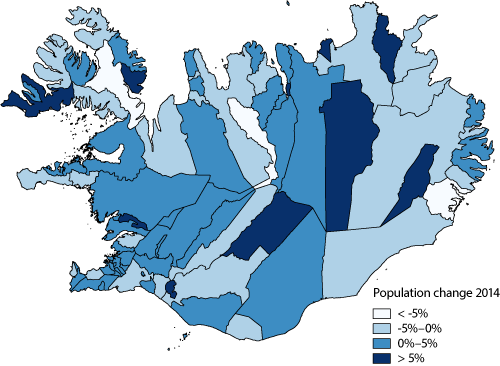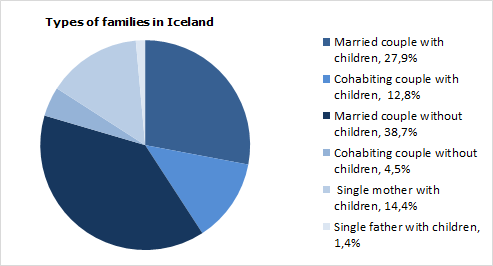The total population 1 January 2015 was 329,100 compared with 325,671 in 2014. This constitutes an increase of 1%. The population declined in three regions, primarily in the Northwest which lost 1.4% of its population in 2014. Five regions experienced a population increase. The region of Suðurnes gained proportionally the most (2.1 %), its population increasing by 466 persons.
The number of municipalities 1 January 2015 was 74, same as in the previous year. Seven municipalities had fewer than 100 inhabitants, 41 had fewer than 1,000 inhabitants and only nine municipalities had more than 5,000 inhabitants. The population relative changes during 2014, by municipality, are presented in figure 1.
Relative change in population between 1st of January 2014 and 2015, by municipality

The number of nuclear families, i.e. couples with or without children under the age of 18 years or single parents with children under 18 years, was 79,354 on 1 January 2015, compared with 78,780 families one year earlier. The distribution of the main types of nuclear families is presented in the following figure.

The dependency ratio was 68.4% 1 January 2014, same as in the previous year. The dependency ratio is calculated as the ratio of the young and old age population relative to the working age population (defined as 20–64 years of age).
Methods
A new definition of localities and urban nuclei has been introduced, in alignment with international recommendations, especially that of the Commission Regulation (EC) No 1201/2009 implementing Regulation (EC) No 763/2008 of the European Parliament and of the Council on population and housing censuses as regards the technical specifications of the topics and of their breakdowns.
As previously announced, mid-year population figures have been replaced by annual average population figures. Those are calculated simply by averaging the start figures of two adjacent years.